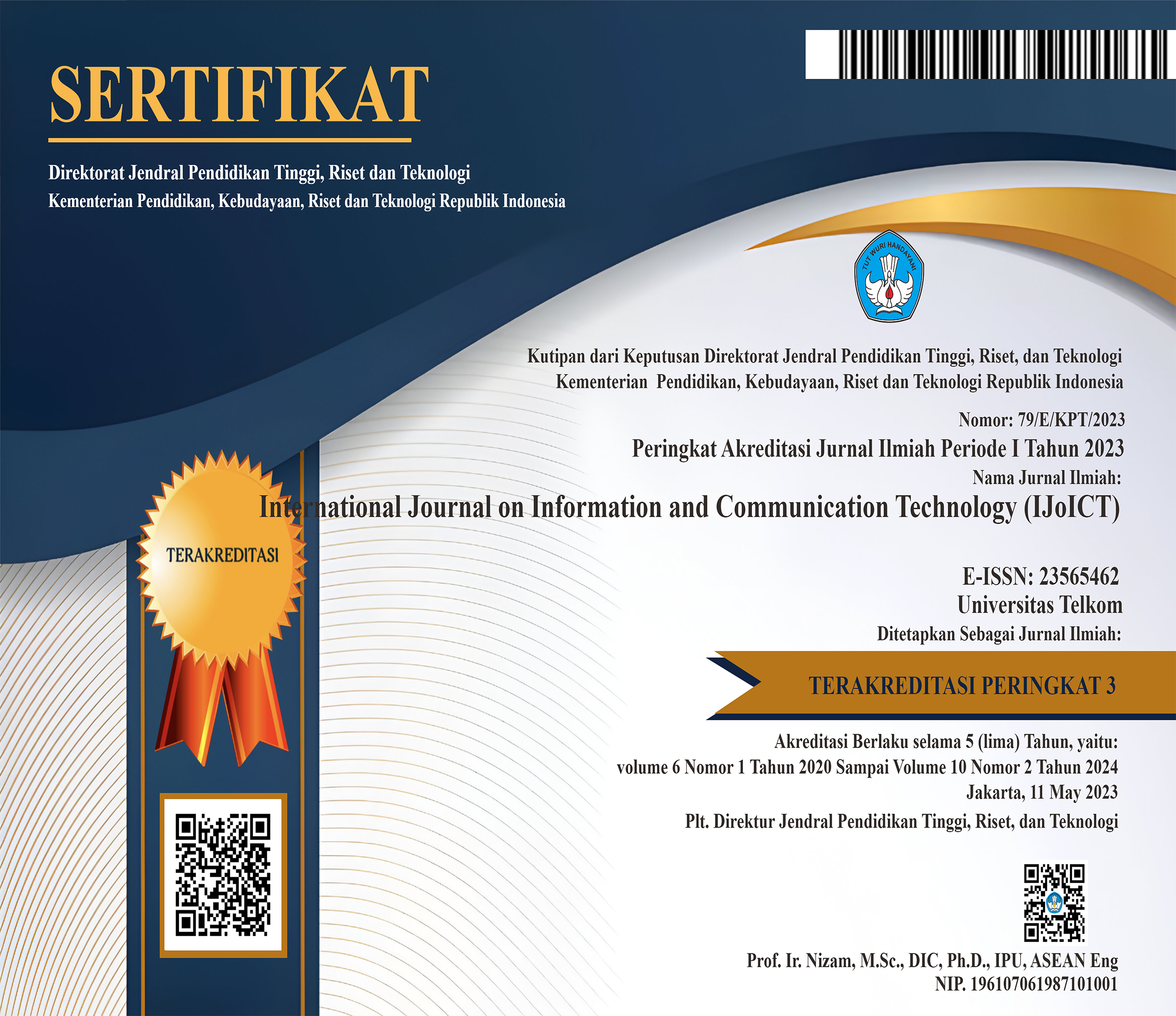Socio-user Context Aware-Based Recommender System: Context Suggestions for A Better Tourism Recommendation
 Abstract views: 93
,
Abstract views: 93
,
 pdf downloads: 74
pdf downloads: 74
Abstract
The existing tourism recommender system model is mostly predictive analytics for destination recommendations (item recommendation). Limited research has been conducted in the discussion of a recommender system model, particularly context suggestion. Thus, it is necessary to develop a recommender system model not only to predict tourism destinations but also to suggest contexts appropriate for tourist preferences (context suggestions). A deep learning method was used to create a model of the socio-user context aware-based recommender system for context suggestions. The attribute used as a label to suggest context was uHijos, uCuisine, uAmbience, and uTransport. The accuracy of the socio-user context aware-based recommender system in suggesting the context of uHijos, uAmbience, and uTransport was 100% with an error rate of 0%. It was found that only the level of recognition of the model in suggesting uCuisine was less accurate (below 30%) with a classification error for more than 70%. Performance evaluation of the socio-user model context-based recommender system was considered efficient, particularly for the evaluation of the level of accuracy, completeness (recall/sensitivity), precision, and a harmonic average of precision and recall (F-score), mainly for label/context of uHijos, uAmbience, and uTransport.
Downloads
References
[2] F. Ricci, L. Rokach, and B. Shapira, “Recommender Systems: Introduction and Challenges,” in Recommender Systems Handbook, Second., F. Ricci, L. Rokach, and B. Shapira, Eds. Boston, MA: Springer US, 2015, pp. 1–34. doi: 10.1007/978-1-4899-7637-6_1.
[3] J. Lu, D. Wu, M. Mao, W. Wang, and G. Zhang, “Recommender system application developments: A survey,” Decision Support Systems, vol. 74, pp. 12–32, Jun. 2015, doi: 10.1016/j.dss.2015.03.008.
[4] B. McKercher, “Towards a taxonomy of tourism products,” Tourism Management, vol. 54, pp. 196–208, Jun. 2016, doi: 10.1016/j.tourman.2015.11.008.
[5] S. Khusro, Z. Ali, and I. Ullah, “Recommender Systems: Issues, Challenges, and Research Opportunities,” in Lecture Notes in Electrical Engineering 376, 2016, pp. 1179–1189. doi: 10.1007/978-981-10-0557-2_112.
[6] J. Illig, A. Hotho, R. Jäschke, and G. Stumme, “A Comparison of Content-Based Tag Recommendations in Folksonomy Systems,” in Knowledge Processing and Data Analysis, 2011, pp. 136–149. doi: 10.1007/978-3-642-22140-8_9.
[7] A. B. Barragáns-Martíneza, E. Costa-Montenegroa, J. C. Burguilloa, M. Rey-Lópezb, F. A. Mikic-Fontea, and A. Peleteiroa, “A hybrid content-based and item-based collaborative filtering approach to recommend TV programs enhanced with singular value decomposition,” Information Sciences, vol. 180, no. 22, pp. 4290–4311, 2010.
[8] A. Bellogín, P. Castells, and I. Cantador, “Improving memory-based collaborative filtering by neighbour selection based on user preference overlap,” in OAIR ’13 Proceedings of the 10th Conference on Open Research Areas in Information Retrieval, 2013, pp. 145–148.
[9] I. Gunes, A. Bilge, and H. Polat, “Shilling Attacks Against Memory-Based Privacy-Preserving Recommendation Algorithms,” KSII Transactions on Internet and Information Systems (TIIS), vol. 7, no. 5, pp. 1272–1290, 2013.
[10] T. M. Chang and W. F. Hsiao, “Model-based collaborative filtering to handle data reliability and ordinal data scale,” in Fuzzy Systems and Knowledge Discovery (FSKD), 2011 Eighth International Conference on Shanghai, 2011, pp. 2065–2069. doi: 10.1109/FSKD.2011.6019879.
[11] Y. Bergner, S. Droschler, G. Kortemeyer, S. Rayyan, D. Seaton, and D. E. Pritchard, “Model-Based Collaborative Filtering Analysis of Student Response Data: Machine-Learning Item Response Theory,” 2012.
[12] G. Adomavicius and A. Tuzhilin, “Toward the next generation of recommender systems: a survey of the state-of-the-art and possible extensions,” IEEE Transactions on Knowledge and Data Engineering, vol. 17, no. 6, pp. 734–749, Jun. 2005, doi: 10.1109/TKDE.2005.99.
[13] C. C. Aggarwal, “Context-Sensitive Recommender Systems,” in Recommender Systems, Cham: Springer International Publishing, 2016, pp. 255–281. doi: 10.1007/978-3-319-29659-3_8.
[14] C. C. Aggarwal, “Time- and Location-Sensitive Recommender Systems,” in Recommender Systems, Cham: Springer International Publishing, 2016, pp. 283–308. doi: 10.1007/978-3-319-29659-3_9.
[15] N. Lathia, “The Anatomy of Mobile Location-Based Recommender Systems,” in Recommender Systems Handbook, Second., F. Ricci, L. Rokach, and B. Shapira, Eds. Boston, MA: Springer US, 2015, pp. 493–510. doi: 10.1007/978-1-4899-7637-6_14.
[16] I. Guy, “Social Recommender Systems,” in Recommender Systems Handbook, Second., F. Ricci, L. Rokach, and B. Shapira, Eds. Boston, MA: Springer US, 2015, pp. 511–543. doi: 10.1007/978-1-4899-7637-6_15.
[17] C. C. Aggarwal, “Social and Trust-Centric Recommender Systems,” in Recommender Systems, Cham: Springer International Publishing, 2016, pp. 345–384. doi: 10.1007/978-3-319-29659-3_11.
[18] D. Buhalis and A. Amaranggana, “Smart Tourism Destinations Enhancing Tourism Experience Through Personalisation of Services,” in Information and Communication Technologies in Tourism 2015, I. Tussyadiah and A. Inversini, Eds. Switzerland: Springer International Publishing, 2015, pp. 377–389. doi: 10.1007/978-3-319-14343-9.
[19] M. Andrejevic and M. Burdon, “Defining the Sensor Society,” Television & New Media, vol. 16, no. 1, pp. 19–36, Jan. 2015, doi: 10.1177/1527476414541552.
[20] P. P. Tallon, “Corporate Governance of Big Data: Perspectives on Value, Risk, and Cost,” Computer, vol. 46, no. 6, pp. 32–38, Jun. 2013, doi: 10.1109/MC.2013.155.
[21] G. Chen and D. Kotz, “A Survey of Context-Aware Mobile Computing Research,” Science, vol. 3755, pp. 1–16, 2000, doi: 10.1.1.117.4330.
[22] B. Schilit, N. Adams, and R. Want, “Context-aware computing applications,” in Workshop on Mobile Computing Systems and Applications, 1994, pp. 85–90. doi: 10.1109/MCSA.1994.512740.
[23] G. D. Abowd, A. K. Dey, P. J. Brown, N. Davies, M. Smith, and P. Steggles, “Towards a Better Understanding of Context and Context-Awareness,” in Computing Systems, vol. 40, no. 3, 1999, pp. 304–307. doi: 10.1007/3-540-48157-5_29.
[24] D. Moen, N. McKelvey, K. Curran, and N. Subaginy, “Context Awareness in Mobile Devices,” Mobile and Wireless Computing. IGI Global, pp. 247–252, 2015. doi: 10.4018/978-1-4666-5888-2.ch559.
[25] P. Gundecha and H. Liu, “Mining Social Media: A Brief Introduction,” in 2012 TutORials in Operations Research, INFORMS, 2012, pp. 1–17. doi: 10.1287/educ.1120.0105.
[26] M. A. Russell, “Mining Facebook: Analyzing Fan Pages, Examining Friendships, and More,” in Mining the Social Web: Analyzing Data from Facebook, Twitter, LinkedIn, and Other Social Media Sites, O’Reilly Media, Inc., 2014, pp. 45–88.
[27] M. A. Russell, “Mining Twitter: Exploring Trending Topics, Discovering What People Are Talking About, and More,” in Mining the Social Web: Analyzing Data from Facebook, Twitter, LinkedIn, and Other Social Media Sites, O’Reilly Media, Inc., 2014, pp. 5–44.
[28] M. A. Russell, Mining the Social Web: Analyzing Data from Facebook, Twitter, LinkedIn, and Other Social Media Sites. O’Reilly Media, Inc., 2014. doi: 10.1081/E-ELIS3-120043522.
[29] Z. Sun et al., “Recommender systems based on social networks,” Journal of Systems and Software, vol. 99, pp. 109–119, Jan. 2015, doi: 10.1016/j.jss.2014.09.019.
[30] C. Biancalana, F. Gasparetti, A. Micarelli, and G. Sansonetti, “An approach to social recommendation for context-aware mobile services,” ACM Transactions on Intelligent Systems and Technology, vol. 4, no. 1, pp. 1–31, 2013, doi: 10.1145/2414425.2414435.
[31] J. Hong, E.-H. Suh, J. Kim, and S. Kim, “Context-aware system for proactive personalized service based on context history,” Expert Systems with Applications, vol. 36, no. 4, pp. 7448–7457, May 2009, doi: 10.1016/j.eswa.2008.09.002.
[32] M.-H. Kuo, L.-C. Chen, and C.-W. Liang, “Building and evaluating a location-based service recommendation system with a preference adjustment mechanism,” Expert Systems with Applications, vol. 36, no. 2, pp. 3543–3554, Mar. 2009, doi: 10.1016/j.eswa.2008.02.014.
[33] H. Gao, J. Tang, X. Hu, and H. Liu, “Exploring temporal effects for location recommendation on location-based social networks,” in Proceedings of the 7th ACM conference on Recommender systems - RecSys ’13, 2013, pp. 93–100. doi: 10.1145/2507157.2507182.
[34] G. Chen and L. Chen, “Augmenting service recommender systems by incorporating contextual opinions from user reviews,” User Modeling and User-Adapted Interaction, vol. 25, no. 3, p. 295, 2015.
[35] H. Wu, K. Yue, X. Liu, Y. Pei, and B. Li, “Context-Aware Recommendation via Graph-Based Contextual Modeling and Postfiltering,” International Journal of Distributed Sensor Networks, vol. 11, no. 8, p. 613612, Aug. 2015, doi: 10.1155/2015/613612.
[36] Z. Xu, L. Chen, and G. Chen, “Topic based context-aware travel recommendation method exploiting geotagged photos,” Neurocomputing, vol. 155, pp. 99–107, May 2015, doi: 10.1016/j.neucom.2014.12.043.
[37] D. Yang, D. Zhang, Z. Yu, and Z. Wang, “A sentiment-enhanced personalized location recommendation system,” in Proceedings of the 24th ACM Conference on Hypertext and Social Media - HT ’13, 2013, pp. 119–128. doi: 10.1145/2481492.2481505.
[38] J.-D. Zhang and C.-Y. Chow, “CoRe: Exploiting the personalized influence of two-dimensional geographic coordinates for location recommendations,” Information Sciences, vol. 293, pp. 163–181, Feb. 2015, doi: 10.1016/j.ins.2014.09.014.
[39] T. H. Dao, S. R. Jeong, and H. Ahn, “A novel recommendation model of location-based advertising: Context-Aware Collaborative Filtering using GA approach,” Expert Systems with Applications, vol. 39, no. 3, pp. 3731–3739, Feb. 2012, doi: 10.1016/j.eswa.2011.09.070.
[40] O. Khalid, M. U. S. Khan, S. U. Khan, and A. Y. Zomaya, “OmniSuggest: A Ubiquitous Cloud-Based Context-Aware Recommendation System for Mobile Social Networks,” IEEE Transactions on Services Computing, vol. 7, no. 3, pp. 401–414, Jul. 2014, doi: 10.1109/TSC.2013.53.
[41] M. A. Domingues, A. M. Jorge, and C. Soares, “Dimensions as Virtual Items: Improving the predictive ability of top-N recommender systems,” Information Processing & Management, vol. 49, no. 3, pp. 698–720, May 2013, doi: 10.1016/j.ipm.2012.07.009.
[42] L. Hong, L. Zou, C. Zeng, L. Zhang, J. Wang, and J. Tian, “Context-Aware Recommendation Using Role-Based Trust Network,” ACM Transactions on Knowledge Discovery from Data, vol. 10, no. 2, pp. 1–25, Oct. 2015, doi: 10.1145/2751562.
[43] X. Ren, M. Song, H. E, and J. Song, “Context-aware probabilistic matrix factorization modeling for point-of-interest recommendation,” Neurocomputing, vol. 241, pp. 38–55, Jun. 2017, doi: 10.1016/j.neucom.2017.02.005.
[44] X. Ramirez-Garcia and M. García-Valdez, “Post-Filtering for a Restaurant Context-Aware Recommender System,” in Studies in Computational Intelligence, 2014, pp. 695–707. doi: 10.1007/978-3-319-05170-3_49.
[45] S. Valencia Rodríguez and H. L. Viktor, “A Personalized Location Aware Multi-Criteria Recommender System Based on Context-Aware User Preference Models,” in IFIP Advances in Information and Communication Technology, 2013, pp. 30–39. doi: 10.1007/978-3-642-41142-7_4.
[46] N. M. Villegas, C. Sánchez, J. Díaz-Cely, and G. Tamura, “Characterizing context-aware recommender systems: A systematic literature review,” Knowledge-Based Systems, vol. 140, pp. 173–200, Jan. 2018, doi: 10.1016/j.knosys.2017.11.003.
[47] M. Unger, A. Bar, B. Shapira, and L. Rokach, “Towards latent context-aware recommendation systems,” Knowledge-Based Systems, vol. 104, pp. 165–178, Jul. 2016, doi: 10.1016/j.knosys.2016.04.020.
[48] Y. Shi, A. Karatzoglou, L. Baltrunas, M. Larson, and A. Hanjalic, “CARS2: Learning Context-aware Representations for Context-aware Recommendations,” in Proceedings of the 23rd ACM International Conference on Conference on Information and Knowledge Management - CIKM ’14, 2014, pp. 291–300. doi: 10.1145/2661829.2662070.
[49] A. Q. Macedo, L. B. Marinho, and R. L. T. Santos, “Context-Aware Event Recommendation in Event-based Social Networks,” in Proceedings of the 9th ACM Conference on Recommender Systems - RecSys ’15, 2015, pp. 123–130. doi: 10.1145/2792838.2800187.
[50] C. Rodríguez-hernández, S. Ilarri, R. Hermoso, and R. Trillo-lado, “DataGenCARS?: A generator of synthetic data for the evaluation of context-aware recommendation systems,” Pervasive and Mobile Computing, vol. 38, pp. 516–541, 2017, doi: 10.1016/j.pmcj.2016.09.020.
[51] B. Vargas-govea, G. González-serna, and R. Ponce-medellín, “Effects of relevant contextual features in the performance of a restaurant recommender system,” in 3rd Workshop on Context-Aware Recommender Systems 2011, CARS 2011 - In Conjunction with the 5th ACM Conference on Recommender Systems, RecSys 2011, 2011, no. May 2014.
[52] M. Thelwall, “Gender bias in machine learning for sentiment analysis,” Online Information Review, vol. 42, no. 3, pp. 343–354, Jun. 2018, doi: 10.1108/OIR-05-2017-0153.
[53] K. Ganesan and C. Zhai, “Opinion-based entity ranking,” Information Retrieval, vol. 15, no. 2, pp. 116–150, Apr. 2012, doi: 10.1007/s10791-011-9174-8.
[54] Y. Zheng, R. Burke, and B. Mobasher, “Splitting approaches for context-aware recommendation,” in Proceedings of the 29th Annual ACM Symposium on Applied Computing - SAC ’14, 2014, pp. 274–279. doi: 10.1145/2554850.2554989.
[55] J. Han, M. Kamber, and J. Pei, Data Mining: Concepts and Techniques, 3rd editio. Elsevier Science & Technology, 2017.

This work is licensed under a Creative Commons Attribution 4.0 International License.
Manuscript submitted to IJoICT has to be an original work of the author(s), contains no element of plagiarism, and has never been published or is not being considered for publication in other journals. Author(s) shall agree to assign all copyright of published article to IJoICT. Requests related to future re-use and re-publication of major or substantial parts of the article must be consulted with the editors of IJoICT.









.png)

.jpg)




